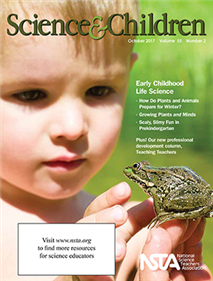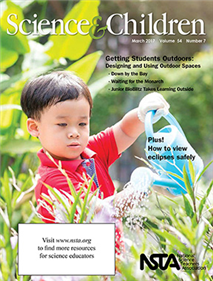All Biology resources
Journal Article
Formative Assessment Probes: Uncovering Young Children’s Concept of a Plant
This column focuses on promoting learning through assessment. This month’s issue uses the “Is It a Plant?” formative assessment probe, which was developed to elicit primary students’ initial ideas about plants and the characteristics they us...
Journal Article
Science 101: How Do Amphibians Breathe?
This column provides background science information for elementary teachers. This month’s issue discusses how all animals breathe, including amphibians....
Blog Post
Using Claim, Evidence, and Reasoning (CER) Strategy to Improve Student Learning
This past school year, I used claim, evidence, reasoning (CER) statements to show three-dimensional learning in my classroom. Several tools are available for doing this, but the one my students like is the CER Graphic Organizer and Transition Words L...
By Cindy Workosky
Blog Post
You Teach What? I’m So Sorry! Building a Better Body and Building Better Argumentation
I am always amazed at the looks on people’s faces when I tell them I teach middle school. They seem to pity me for having a position I chose and love! They inform me that middle school “tween-agers” are argumentative, stubborn, and at times, ad...
By Cindy Workosky
Blog Post
My ‘Phenomenal’ Journey in Elementary
I am the type of educator who gets very excited about new strategies, new and innovative technology, and new activities for students. However, I was more nervous about than excited about to choosing phenomena for my science units. I felt tremendous p...
By Cindy Workosky
Blog Post
Introducing Crosscutting Concepts in the Elementary Grades
Four years ago, I moved from teaching middle school science to teaching grades 2–5 STEAM (science, technology, engineering, art, and mathematics) labs. One of the biggest challenges I faced was limited lab time in our elementary school. Because we ...
By Cindy Workosky
Journal Article
The Early Years: Exploring Biodiversity
This column discusses resources and science topics related to students in grades preK to 2. The objective in this month’s issue is to introduce children to the diversity of plant life in a given area through a plant scavenger hunt, and to guide chi...
Journal Article
Science 101: Does the Weather Affect Your Body?
This column provides background science information for elementary teachers. This month’s issue focuses on three major weather factors and how they affect the human body—temperature, humidity, and air pressure....





